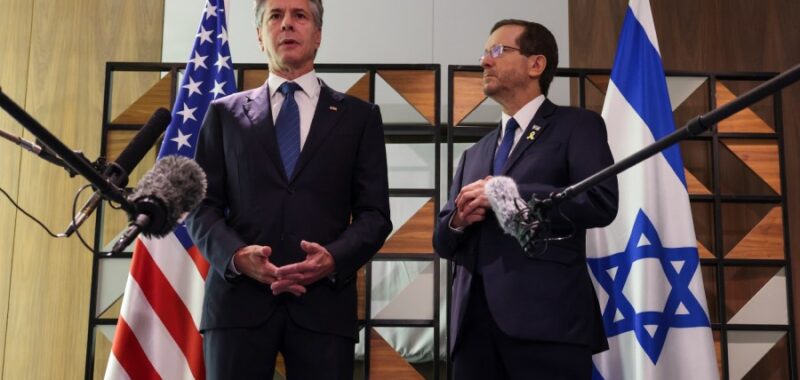
Secretary of State Antony Blinken on Monday said Israeli Prime Minister Benjamin Netanyahu accepted a final, bridging proposal to finalize a cease-fire deal in the Gaza Strip and put the onus on Hamas to bring the agreement to a close.
“In a very constructive meeting with Prime Minister Netanyahu today, he confirmed to me that Israel accepts the bridging proposal, that he supports it,” Blinken said during a press conference from the U.S. Embassy in Jerusalem.
“It’s now incumbent on Hamas to do the same.”
The U.S., along with mediators from Egypt and Qatar, is working to reach a cease-fire deal between Israel and Hamas by the end of the week, one that would seek to bring to an end more than 10 months of war that have wracked the Middle East, triggered by Hamas’s Oct. 7 attack on Israel.
An estimated 40,000 Palestinians have been killed by Israel in the subsequent war, according to the Hamas-run Health Ministry in the Gaza Strip, but which does not distinguish between civilians and combatants.
But Hamas has generally rejected the statements coming out of the cease-fire talks over the past few weeks. The group, which is designated as a terrorist organization by the U.S., said it had agreed to a cease-fire proposal laid out on July 2, but it accused Netanyahu of putting up new conditions that made it impossible for it to accept.
Among Hamas’s demands include agreement on a permanent cease-fire and comprehensive withdrawal of Israeli forces from the Gaza Strip – conditions that were not included in the cease-fire framework first proposed by President Biden on May 31.
Blinken raised doubts on Hamas’s public statements and apparent rejections of where cease-fire talks currently stand.
“We’ve seen public statements before that don’t fully reflect where Hamas is,” Blinken said.
“The critical next step is for Hamas to accept the bridging proposal that Prime Minister Netanyahu has now accepted, and then to engage with everyone else on making sure that we have clear understandings of how each party would actually implement the commitments that it’s undertaken in this agreement.”
The terms of the cease-fire deal between Israel and Hamas are generally laid out to begin with a six-week truce that would require Hamas to release hostages it kidnapped from Israel on Oct. 7 during its terrorist attack, and for Israel to release Palestinian prisoners from Israeli jails.
During this time, the U.S. and partners are expected to dramatically scale up delivery of humanitarian assistance to Palestinian’s in the Gaza Strip. Throughout the six-week truce, the U.S., Qatar and Egypt are expected to mediate more negotiations between Israel and Hamas for a permanent end to the war.
Blinken said there is a “real sense of urgency” in Israel and across the region for the need to get the cease-fire deal across the finish line, as fighting has escalated across multiple fronts.
Hamas took credit on Sunday for a suicide-bombing in Tel Aviv that injured one person, and warned of bringing these “operations… to the forefront.” This followed spiraling violence in the West Bank, with the Israeli government condemning attacks by extremist Israeli settlers on a Palestinian village, killing one person.
Israel and Hezbollah and Lebanon continue to trade rocket fire over Lebanon’s southern border, as a broader Iranian attack against Israel looms – in retaliation for the alleged Israeli assassination of a top Hamas political leader in Tehran on July 31.
The U.S. has dispatched significant military resources to the Middle East to help defend Israel in case of an Iranian attack, with Blinken warning on Monday against all parties from taking actions that would escalate conflict.
“What’s most crucial now is that everyone,” he paused and stressed again, “everyone, refrain from taking any actions that could fuel further conflict, escalate tensions and result in the spreading of violence and conflict.”

